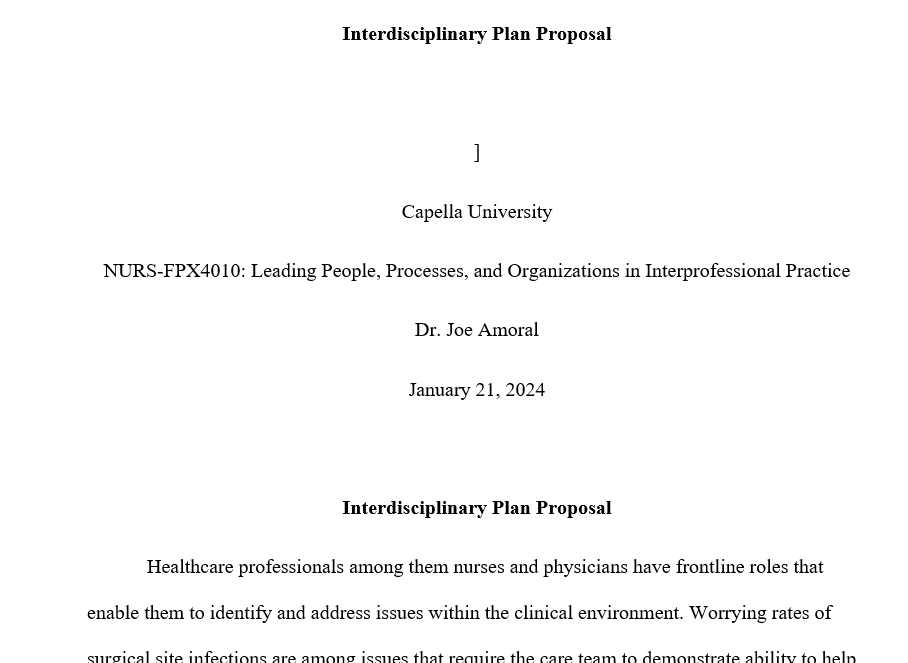NURS-FPX4010_S_Assessment 3-1 solution.docx
Interdisciplinary Plan Proposal
Capella University
NURS-FPX4010: Leading People, Processes, and Organizations in Interprofessional Practice
Dr. Joe Amoral
January 21, 2024
Interdisciplinary Plan Proposal
Healthcare professionals among them nurses and physicians have frontline roles that enable them to identify and address issues within the clinical environment. Worrying rates of surgical site infections are among issues that require the care team to demonstrate ability to help their organization improve quality, safety, and cost of care.
Timely responses reduce the risk of morbidity, mortality, and additional costs for patients and the organization. This plan addresses the need for interdisciplinary safety rounds as part of the comprehensive care bundle designed to reduce surgical site infections. The strategy promotes coordinated and collaborative efforts necessary for monitoring and intercepting risks.
Objectives
- To inform nurses, physicians, and clinical assistants about the relevance of safety rounds in improving cost, quality, and safety of patient care. The educational approach makes everyone familiar with surgical site infections, consequences, and interventions necessary to maintain a safe clinical environment (Sartelli et al., 2020).
- To clarify an interdisciplinary plan for the care team to adopt when monitoring, identifying, and intercepting risk factors. The plan highlights the causes, implications, and timely interventions for safeguarding patients from prolonged hospitalization, readmission, and additional costs (Sartelli et al., 2020).
- To emphasize the need for team-based values, beliefs, attitudes, and behaviors. The objective reminds the audience about frontline roles and qualities and traits appropriate for optimizing care outcomes.
Questions and Predictions
- How will the plan influence the team’s commitment to preventing surgical site infections? Interdisciplinary safety rounds is a viable alternative for the care team to adhere to practices such as bowel preparation, skin preparation, disinfection and hygiene, and use of clean instruments for closure during and after surgery.
- How does the interdisciplinary approach contribute to better safety and quality outcomes? Collaborative efforts encourage healthcare professionals to demonstrate positive attitudes, behaviors, and values that allow everyone to share details of risk factors and timely interventions to avoid issues escalating to serious levels (McNicholas et al., 2019).
- Are interdisciplinary safety rounds sustainable for preventing surgical site infections?
The intervention is sustainable since it creates opportunities for the care team to uphold team-based functions and values that strengthen safety culture.
- How will the plan be implemented within the medical-surgical unit?
The plan will include training and education with the audience participating in role-plays and viewing video simulations to familiarize with interdisciplinary safety rounds. The audience will acquire practical skills on the procedures for consistent use of safety rounds to eliminate risks associated with surgical site infections.
Change Management and Leadership Strategies
Successful change will require the team to utilize the Plan-Do-Study-Act. The framework is ideal for improving a process and carrying out meaningful changes. The initial step is to assemble a team that understands the problem and sees an opportunity for improvement.
The transformational leader is preferred for implementation interdisciplinary safety rounds using the PDSA model. The leader identifies forward-thinking staff and encourages everyone to dedicate time and efforts to produce the intended outcomes (Hussain et al., 2018). In this case, the transformational leader considers the strength of each team member, communicates roles and responsibilities, and set timelines.
The PDSA model also allows the team to clarify the aim by specifying intended accomplishments, procedures for ascertaining improvement, and adjustments necessary to meet requirements (McGowan & Reid, 2018). The transformational leader ensures that everyone understand the context and process. The leader clarifies the prevailing situation, steps for adopting interdisciplinary safety rounds, and improvements necessary to establish and maintain a safe clinical environment.
Team Collaboration Strategies
The team has nurses, physicians, clinical assistants, operating room supervisor, nurse manager, and an administrator. Frontline knowledge, skills, and experiences make the group appropriate for implementing interdisciplinary safety rounds. The collaboration involves training, education, and briefings to make everyone familiar with the action steps and progress (Weiser et al., 2018).
Everyone gets the chance to share suggestions on practices for streamlining interdisciplinary safety rounds and identifying risk factors associated with surgical site infections. The collaboration strategy will also include role-plays and video simulations to enable the team acquire practical knowledge of safety rounds and their implications on surgical site infections.
Organization Resources
The organization has several resources available to implement interdisciplinary safety rounds successfully. Adequate funds allocated for the project will ensure a seamless flow of procedures associated with safety rounds.
The other resource is competent leaders such as the nurse manager with experience on addressing safety issues. Technological capabilities also make it easier to utilize video simulations to enable the care team visualize interdisciplinary safety rounds and their relevance in reducing surgical site infections.
| Item | Description | Cost ($) |
| Interdisciplinary collaboration notes | The notes make the audience familiar with procedures for initiating and maintaining effective interdisciplinary collaboration across the continuum. | 150 |
| Nurse educator | The educator has knowledge and experience on interdisciplinary practices and strategies for using the framework to optimize care outcomes. | 1,500 |
| Role play scripts | The scripts clarify procedures for using interdisciplinary safety rounds to identify and intercept risk factors associated with surgical site infections. | 200 |
| Video sessions | Video sessions make the training and education interesting and more meaningful in highlighting the role of interdisciplinary collaboration in enhancing quality and safety of patient care. | 500 |
| TOTAL | 2,350 |
References
Hussain, S. T., Lei, S., Akram, T., Haider, M. J., Hussain, S. H., & Ali, M. (2018). Kurt Lewin’s change model: A critical review of the role of leadership and employee involvement in organizational change. Journal of Innovation & Knowledge, 3(3), 123-127.
McGowan, M., & Reid, B. (2018). Using the Plan, Do, Study, Act cycle to enhance a patient feedback system for older adults. British Journal of Nursing, 27(16), 936–941.
McNicholas, C., Lennox, L., Woodcock, T., Bell, D., & Reed, J. E. (2019). Evolving quality improvement support strategies to improve plan–do–study–act cycle fidelity: A retrospective mixed-methods study. BMJ Quality & Safety, 28(5), 356–365. https://pubmed.ncbi.nlm.nih.gov/30886118/
Sartelli, M., Pagani, L., Iannazzo, S. et al. (2020). A proposal for a comprehensive approach to infections across the surgical pathway. World Journal of Emergency Surgery, 15(13), 1-24. https://doi.org/10.1186/s13017-020-00295-3
Weiser, M.R., Gonen, M., Usiak, S., Pottinger, T., Samedy, P., Seo, S., Smith, J., Temple, L., Nash, G.M., Paty, P., Cheavers, C.E., Eagan, J., & Garcia-Aguilar, J. (2018). Effectiveness of a multidisciplinary patient care bundle for reducing surgical-site infections. British Journal of Surgery, 105, 1680-1687. https://www.ncbi.nlm.nih.gov/pmc/articles/PMC6190910/



